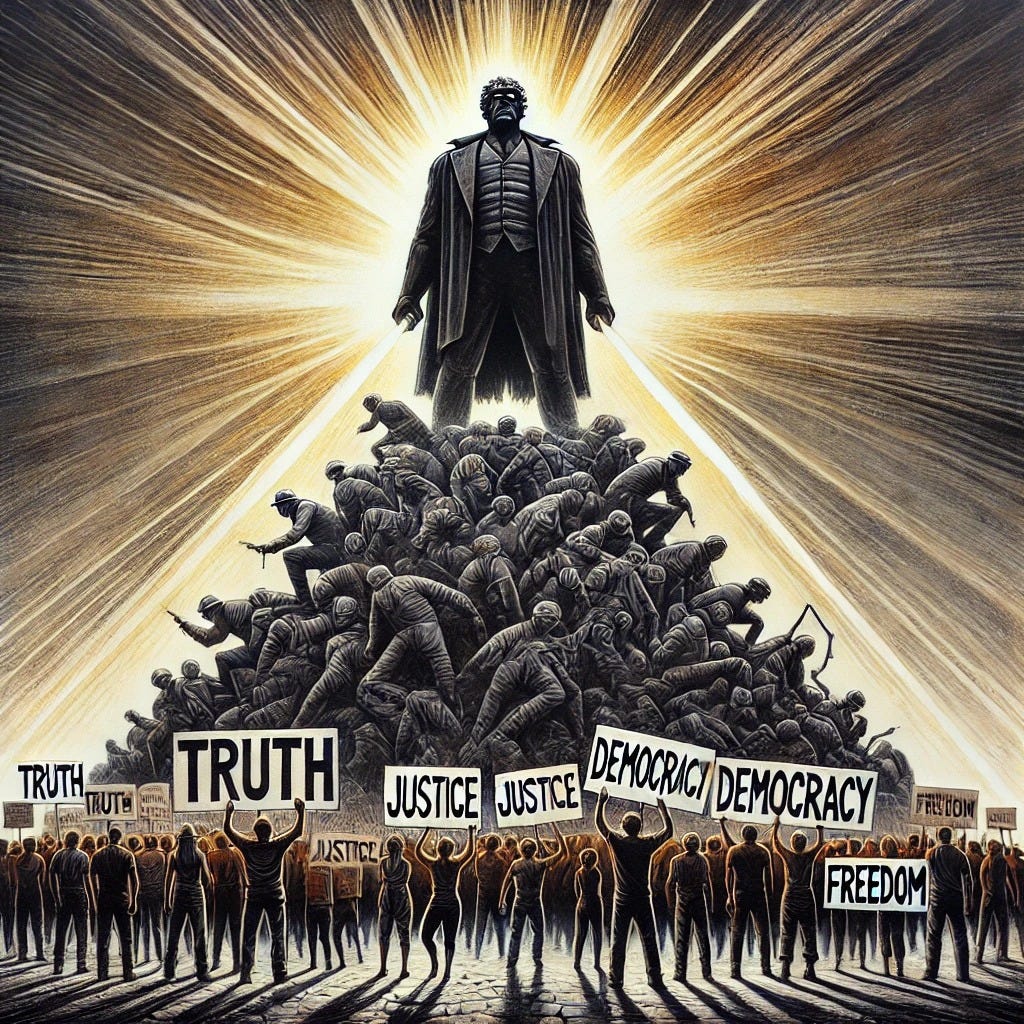✍️ Beyond Left and Right: Understanding Today’s Authoritarian Leaders—Trump Included
Why ideology is a distraction—and control is the point.
Authoritarianism Is on the March—Here and Abroad
Donald Trump didn’t invent authoritarianism. But he’s reshaping the U.S. presidency in its image.
In just the past few months, we’ve seen aggressive executive orders, open threats to independent agencies, attacks on journalists, and loyalty demands from judges and military officials.
His political machine has intensified efforts to discredit opponents, bypass Congress, and consolidate control. Around the world, other leaders are doing the same.
This isn’t just a policy debate. It’s not about left or right.
It’s about power—and whether we still believe in the democratic limits that protect freedom.
We’re used to thinking of political beliefs along a left-right spectrum: liberals vs. conservatives. Democrats vs. Republicans. Socialism and communism on the far left, fascism and Nazism on the far right.
That model still has value, but it no longer explains what we see from many of today’s world leaders.
Some leaders claim to be conservative. Some say they’re socialists. But when you look at how they govern, the label that fits best isn’t left or right. It’s authoritarian.
It’s About Power, Not Policy
Authoritarianism means power concentrated in the hands of one person or group. It’s marked by attacks on the press, limits on free speech, weakened courts, rigged elections, and the silencing of political opponents.
Some authoritarian governments promote conservative social values—like limiting LGBTQ+ rights, enforcing strict gender roles, and promoting religious traditionalism. Others control the economy or claim to speak for the working class.
But ideology isn’t what drives them. Control is.
Profiles in Authoritarianism
Vladimir Putin – Russia
Putin rules with a mix of nationalism and religious traditionalism, grounded in Russian Orthodox values. He promotes strict ideas about family, gender, and national pride. He jails and murders opponents, censors the news media, and spreads disinformation (lies).
His invasion of Ukraine is part of a larger goal: reclaiming former Soviet territory and silencing democracy at his borders.
Xi Jinping – China
Xi leads a one-party state where dissent is crushed, and surveillance is widespread. He’s ended term limits and centralized power under the Communist Party. While China allows some private enterprise, Xi enforces total political loyalty and uses technology and propaganda to maintain control.
Kim Jong-un – North Korea
Kim runs a full-blown dictatorship. Citizens have no political rights, no free speech, and no access to independent news. Loyalty to the regime is mandatory. His government controls every aspect of life—making it a rare example of totalitarianism, not just authoritarianism.
Viktor Orbán – Hungary
Orbán still holds elections, but the playing field is rigged. He’s stacked the courts, weakened the free press, and changed election rules to favor his party.
Some critics call Hungary a “democracy in name only”—a country where opposition parties exist but real competition is blocked. He pushes anti-immigrant rhetoric and claims to defend “Christian values.”
Donald Trump – United States
Trump continues to undermine democratic norms. He still spreads false claims about voter fraud, attacks the news media and the justice system, and praises authoritarian leaders. He pressured election officials to overturn election results and incited a violent attempt to stop the peaceful transfer of power.
He remains a formidable threat in U.S. politics, and his influence continues to erode trust in democratic institutions.
What Unites Them? Power Above All
These leaders don’t share the same politics. Some favor big government, some don’t. Some use religion, some rely on economic promises. But they all follow the same script:
Undermine trust in the news media and elections
Blame outsiders or political enemies
Concentrate power in their own hands
Portray themselves as the only solution
Authoritarianism doesn’t need a consistent ideology. It just needs an audience willing to trade away freedom for promises of strength, safety, or national pride.
Why This Matters in the United States
We’re not immune. Trump brought the tactics of authoritarianism to the heart of U.S. politics. And other politicians have followed his lead. Across the country, we’re seeing efforts to suppress votes, discredit election officials, restrict the teaching of history, and punish dissent.
As I already wrote, this isn’t about left or right. It’s about whether we believe in democracy—or we let it slip away.
Be Informed. Speak the Truth. Push Back.
Authoritarianism rarely arrives with a warning label. It often shows up in patriotic colors, mentioning the Constitution, while quietly dismantling the systems that hold power in check.
That’s why it’s up to us—not just elected leaders—to recognize what’s happening, speak out, and defend democratic values. Stay informed. Share the truth.
And when you see power being abused, call it what it is.
Also see: Democracy in Name Only: When Elections Exist but Freedom Doesn’t
Why elections aren’t enough—and how today’s leaders (Trump included) rig the system while claiming legitimacy.
Related Resources
🟦 Executive Overreach & Abuse of Power
A ranked guide to organizations resisting authoritarianism and defending democratic norms.
🟦 Trump, MAGA & Right-Wing Resistance
Top organizations taking action against Donald Trump, MAGA politics, and radical right-wing agendas — now and into 2026+
A ranked guide to legal groups challenging anti-democratic policies and abuses of power.
🟪 Ukraine, Democratic Values & Global Alliances
A ranked guide to organizations supporting Ukraine, defending democracy, and strengthening global alliances against authoritarianism.
📰Progressive Media Sources for News, Ideas, & Action
Fact-based journalism with a progressive lens—informing movements, shaping change.




